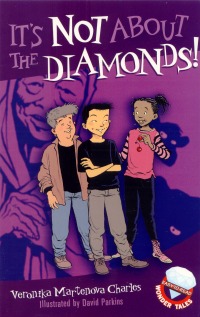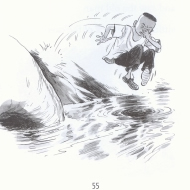| ________________
CM . . .
. Volume XIX Number 31. . . .April 12, 2013
excerpt:
The genre of children's folklore is a treasure amidst the variety of text choices children are faced with. As children move through both academic and life stages of growth and development, it is the rich stories of tradition and moral tales that will frame the literature that they will continue to read. It's refreshing to see folklore in the field of children's literacy as too often students are pulled by graphic text and lighter content messages. Folklore brings students back to a historical story, rich in values education and cultural awareness. It's Not About the Diamonds! contains three tales told by three different friends during a shared lunch hour at school. The tales are woven together by the theme of kindness and greed; selflessness and selfishness. The stories are founded on the original tale called Diamonds and Toads, by Charles Perrault (1628-1703). The story is also tagged as The Kind and The Unkind Girls.
The original, Diamonds and Toads, carries a typical folklore structure, and the three versions Charles retells model it closely. Each tale has siblings as characters – a good daughter, and a selfish daughter, a kind son, and a mean, selfish son. The 'mean' characters display vices of laziness, greed, selfishness and envy while the 'good' characters display virtues of fortitude, generosity, selflessness and humility. In each story, the 'good' child receives some sort of fortune – accidently and not coveted. The 'mean' child, however, covets the treasure and is determined to receive the same reward, regardless of how it is attained. Can you guess the fate of the 'good' child vs. the 'mean' child? The stories are simple and short, and yet they carry a powerful message that children will carry with them forever. The moral tension and temptation created in these tales are a sample of the literacy elements children will reference throughout their literary lives. I particularly like how the stories are told throughout a school lunch hour amongst friends. Charles captures the language and energy of a middle school lunch hour where kids are scoping out each other's lunch items to request a trade or 'nudge a share'. It's obvious that these youth have been created to have the kindness and compassion of the 'good' characters in each version of the Diamonds and Toads stories retold by Charles. The school friends are polite, kind, and thoughtful which are the values identified in the 'good' sibling from each tale. Such values are universal and are evident in the characters Charles creates to tell the stories within the story. The story layers work well with the school friends acting as storytellers. The simple cafeteria movement and typical lunch table conversations work well to transition each of the storytellers into telling their version of Diamonds and Toads. It's a wonderful structure for readers to build their background knowledge of tales from around the world. Students can see that Disney and Pixar aren't the only storytellers on the globe! Highly Recommended. Carrie Subtelny is a consultant, reading clinician, tutor, and literacy advocate in Winnipeg, MB.
To comment
on this title or this review, send mail to cm@umanitoba.ca.
Copyright © the Manitoba Library Association. Reproduction for personal
use is permitted only if this copyright notice is maintained. Any
other reproduction is prohibited without permission.
NEXT REVIEW |
TABLE OF CONTENTS FOR THIS ISSUE
- April 12, 2013
AUTHORS |
TITLES |
MEDIA REVIEWS |
PROFILES |
BACK ISSUES |
SEARCH |
CMARCHIVE |
HOME |

 The first rendition by Veronika Martenova Charles is called "Three Gnomes", and it is a story from Germany. This is the author's retelling of the Grimm's tale The Three Little Gnomes in the Forest. The second story she tells is called "Rice Cakes", and it is based on story from Bali. The third story, this one from Kenya, is called "Old Man of the River".
The first rendition by Veronika Martenova Charles is called "Three Gnomes", and it is a story from Germany. This is the author's retelling of the Grimm's tale The Three Little Gnomes in the Forest. The second story she tells is called "Rice Cakes", and it is based on story from Bali. The third story, this one from Kenya, is called "Old Man of the River".